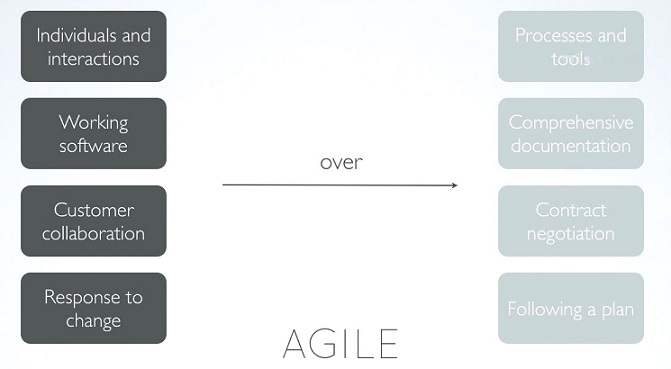CSC/ECE 517 Fall 2013/ch1 1w39 as: Difference between revisions
No edit summary |
No edit summary |
||
| Line 11: | Line 11: | ||
Some of the process under agile development includes adaptive planning, evolutionary development and delivery, a time-boxed iterative approach, and encourages rapid and flexible response to change. It is a conceptual framework that promotes foreseen interactions throughout the development cycle. | Some of the process under agile development includes adaptive planning, evolutionary development and delivery, a time-boxed iterative approach, and encourages rapid and flexible response to change. It is a conceptual framework that promotes foreseen interactions throughout the development cycle. | ||
[[File:agl39.jpg|frame|Fig 1:Agile development]] | [[File:agl39.jpg|center|frame|Fig 1:Agile development]] | ||
Revision as of 02:04, 7 October 2013
This article focuses on how Rails enables ‘’’agile development practices’ and the characteristics of Rails that support specific agile methodologies.
Agile development
What is it?
Agile development is a methodology where requirements and solutions are developed based on iterative and incremental development<ref>http://en.wikipedia.org/wiki/Iterative_and_incremental_development</ref> through collaboration between self-organizing, cross-functional teams. Using agile development methodology, a high quality software can be developed by programmers in a minimal amount of time.
Some of the process under agile development includes adaptive planning, evolutionary development and delivery, a time-boxed iterative approach, and encourages rapid and flexible response to change. It is a conceptual framework that promotes foreseen interactions throughout the development cycle.

How Rails supports Agile Methodologies
Generators help you setup a wireframe fast
- The command “rails generate” uses templates to create models, controllers, views, databases, etc which helps to setup a test application.
- The scaffolding can be easily done to deploy any basic web -application, and developers can extend them to implement their functionalities. This overcomes the initial hurdle.
Ready Setup for Multi-environment
- Rails application provides development, production and testing environments with built-in configurations setup and thus is a huge time saver for an application which is required to be deployed in multiple environments.
- The built-in rails web-server has the development environment as the default environment.
- Simple deployment allows developers to have face-face client meetings and thus make instantaneous changes based on the client requirements.
Test-Driven Development
- Built in mocking and stubbing frameworks are available which assists “how to write code”. This follows a red, green and refactor which is an important aspect of agile development.
- RSpec is one of the famous testing framework tools used with rails.
- Other testing tools can also be swapped in.
Dependency Management
- Rails acts more than a web framework by providing the necessary utility and support tools and adding dependencies to individual projects in a jiffy using the “bundler”.
- This bundler installs all the relevant gem files and also can be updated when more dependencies are added. No need to search for packages or jars.
Responding to Change
- Rails helps you to keep easy track of database changes with the help of Migration Objects. It gives the flexibility to rollback and update.
- It also allows you to maintain various versions of database for the multi-environment. On running rake db::migrate, the desired database is migrated and deployed with the working rails server.
- New technologies such as Coffeescript can also be easily embedded by installing the relevant gems thus adapting to the changing technology.
Assets Pipeline
- The assets pipeline is a new feature embedded in rails ( which is now extracted into sprockets-rails gem), concatenates and compresses javascript and css files.
- This renders a web page with reduced number of requests from the browser as files are grouped and whitespaces are trimmed.
- Precompiled files can also be attached.
Don’t Repeat Yourself (DRY)
- Repeated code is written in helpers and libraries, making a single destination and thus updations become simpler by updating at just one place.
- Partials are a way of rendering repeated HTML code. Rails understand a file which starts with an underscore, say, _partial.html as a partial to be included in the shared html file which renders it.
References
<references/>